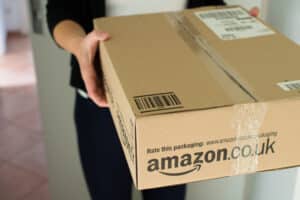
Amazon has been accused of being “no friend of the small business” after a report discovered evidence that the online marketplace has ramped up fees and advertising costs for sellers.
It found that between 2017 and 2022 Amazon had tripled the amount it earned from fees for independent sellers in Europe, including for listings, deliveries and digital support. That growth far outstripped the rise in sales, which doubled over the same period.
Analysis of delivery and storage costs for sellers in the UK, France, Germany, Spain and Italy, for example, found prices had more than doubled in some categories between 2017 and 2023.
Margarida Silva, a researcher at the Amsterdam-based Centre for Research on Multinational Corporations, also known as Somo, accused the internet retailer of exploiting a “captive clientele”.
“For the past 20 years Amazon has been expanding its monopolistic hold over online shopping in Europe. It is now so dominant that independent retailers who wish to sell online cannot avoid it. Sellers are locked in to the platform and essentially a captive clientele, making them a profitable source of monopoly rent,” she said.
Income from sellers’ fees jumped 6% last year to €23.5bn, even as retail sales fell 1%, according to Somo’s analysis of accounts for the group’s European arm, Amazon EU Sarl.
Those fees do not include the amount sellers are charged to advertise on the site. Amazon’s overall advertising revenue has boomed in recent years: to €5.4bn in 2021 from just €0.3bn in 2017, according to Somo’s analysis of local Amazon subsidiaries that book its ad services across Europe. The group estimates that 51% of that amount, or €2.75bn, comes from independent sellers.
At Amazon Online UK, the subsidiary that handles UK ad bookings, advertising revenue rose from €0.3bn in 2018 to €1.9bn in 2021 – a sixfold increase. The more sellers and other business clients bid for a specific keyword, the more expensive it gets.
“Amazon sellers seem to be increasingly shouldering Amazon’s costs, including the costs of the expansion of its network of fulfilment centres and also the digital services taxes in France and the UK,” Somo’s report says.
It adds: “Amazon’s squeezing of sellers is a crucial pillar of its European business as revenue from independent sellers’ fees is growing faster than its core business, its European retail arm.”
One UK seller told the Guardian that his fees, including advertising, amounted to almost 40% of the pre-VAT price of his products. “Sales are satisfactory and stagnant, which maybe I can’t blame Amazon for, but fees are quite high and service is poor,” he said.
Amazon is under investigation by the UK’s competition watchdog over whether it has been giving its own brands and those using its logistics services unfair advantage over third-party rivals on its online marketplace.
A separate European Commission investigation looked at similar issues last year, resulting in Amazon making a series of commitments to address the concerns, including a centralised complaint mechanism open to all sellers and delivery firms.
Amazon said its revenue had increased because its European sellers had “grown their businesses through Amazon”, adding: “Amazon is investing more than ever in supporting the growth of our selling partners and helping them achieve record sales … Sellers who choose to purchase optional logistics or advertising services from Amazon do so because they see incremental value to their business.”
The retailer said paying for Amazon to store, pick, pack and deliver products was an optional service, which it claimed was 30% cheaper than standard services offered by other major logistics operators, and buying advertising was also optional.
Amazon said it strongly disagreed with Somo’s characterisation of its market position as monopolistic. It said the market share figures “fundamentally misrepresent how the retail industry works” because they did not take into account that most retail sales are made in physical stores, adding: “The retail space is incredibly competitive and dynamic, and sellers have many options to choose where to sell goods.”
Amazon said its revenue from independent sellers amounted to 60% of the volume of items sold on the site and it had “long celebrated that their sales are growing faster than Amazon’s own sales … We have also invested billions in new tools and services for sellers to help them succeed.”
European sellers spoken to for the report said they felt impelled to pay the rising costs as the online marketplace has such a high market share – as much as 70% in Germany, France and Spain according to a report by the European Commission.
A UK retailer told Somo that sellers are incentivised to keep spending on advertising services to keep the visibility for their products: “Like a hamster on a wheel, you have to just keep going. As soon as you slow the pace, then they’ll just go your competitor.”
Amazon has refused to disclose data on sellers’ sales values on European marketplaces. However, the company said that independent and third party European sellers “sold more than 2.2bn products worldwide in 2021, which it told Somo was up 65% over two years. Somo said that revenue Amazon had received from sellers’ listings had increased by 85% over that two-year period.
Amazon said the seller figure included third sellers and independent businesses.
Read more:
Amazon under fire for tripling sellers’ fees and advertising costs






